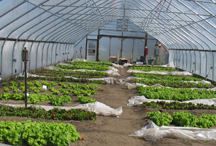
Northern N.Y. Two farm tours and a workshop in March will showcase season extension vegetable production, including the results of research funded by the farmer-driven with funding support from the Northern New York Agricultural Development Program serving Clinton, Essex, Franklin, Jefferson, Lewis and St. Lawrence counties. The tours, organized by Cornell Cooperative Extension, will visit growers known for their success with winter season production of fresh produce.
A Monday, March 5 tour at Pleasant Valley Farm, owned by Paul and Sandy Arnold in Argyle, NY, will be available by pre-registration only. Paul, Sandy and Kim Arnold will talk with tour visitors about how they grow winter vegetables with little to no heat in their high tunnels. The Arnolds have been selling winter-grown produce at markets since 2006. They have used low tunnels since 1993. Visitors will see tunnels in full production. Tour organizer Amy Ivy, a regional vegetable specialist with the Eastern New York Commercial Horticulture Program, says, “The Arnolds run one of the best known winter growing operations in New York State.”
Space is limited for the free March 5 tour; preference will be given to commercial growers and would-be growers in Clinton, Essex, Franklin, Jefferson, Lewis and St. Lawrence counties. Register at https://enych.cce.cornell.edu/event.php?id=904 or contact Amy Ivy at adi2@cornell.edu, 518-570-5991.
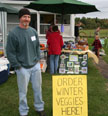 On Saturday, March 24, Ivy will lead a “Growing Vegetables to Sell in Northern New York” workshop for those already commercially growing vegetables and those considering expanding their vegetable production to commercial scale. She will focus on growing vegetables in the spring and fall seasons in spite of the cold climate of Northern New York. The discussion will include using high and low tunnels and row covers.
On Saturday, March 24, Ivy will lead a “Growing Vegetables to Sell in Northern New York” workshop for those already commercially growing vegetables and those considering expanding their vegetable production to commercial scale. She will focus on growing vegetables in the spring and fall seasons in spite of the cold climate of Northern New York. The discussion will include using high and low tunnels and row covers.
This free 10 am to 12 pm workshop will be held at Colwell’s Farm Market and Garden Center in Glenfield, NY. Registration is required by March 21. Signup online at https://reg.cce.cornell.edu/GrowingVegetables_223 or contact Mellissa Spence at Cornell Cooperative Extension Lewis County at mms427@cornell.edu, 315-376-5270.
Funding for the Northern New York Agricultural Development Program is supported by the New York State Senate and administered by the New York State Department of Agriculture and Markets.
Find NNY horticultural research projects information under the Horticulture tab on this website.
 Northern N.Y. The farmer-driven Northern New York Agricultural Development Program has posted its annual report at
Northern N.Y. The farmer-driven Northern New York Agricultural Development Program has posted its annual report at 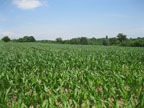 Cornell University Nutrient Management Program Director Dr. Quirine M. Ketterings is cited in the report crediting the farmers and farm advisers in Northern New York as “the frontrunners” prompting re-evaluation of the Cornell corn production guidelines. The farmers who prioritize and select projects for Northern New York Agricultural Development Program funding requested research into how advances in corn breeding and production practices are impacting crop yield and whether it was time to update the associated nitrogen application guidelines for agronomic and economic efficiency.
Cornell University Nutrient Management Program Director Dr. Quirine M. Ketterings is cited in the report crediting the farmers and farm advisers in Northern New York as “the frontrunners” prompting re-evaluation of the Cornell corn production guidelines. The farmers who prioritize and select projects for Northern New York Agricultural Development Program funding requested research into how advances in corn breeding and production practices are impacting crop yield and whether it was time to update the associated nitrogen application guidelines for agronomic and economic efficiency.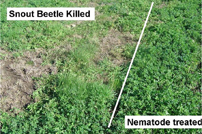 A brief section in the report points to multi-state interest in the biocontrol crop pest solution built by the long-term commitment of the farmers of the Northern New York Agricultural Development Program to developing the science needed to manage the devastating alfalfa snout beetle.
A brief section in the report points to multi-state interest in the biocontrol crop pest solution built by the long-term commitment of the farmers of the Northern New York Agricultural Development Program to developing the science needed to manage the devastating alfalfa snout beetle.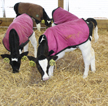
 Northern N.Y.; December 12, 2017. Research funded by the farmer-driven Northern New York Agricultural Development Program is helping regional dairies reduce the risk of winter-related mastitis.
Northern N.Y.; December 12, 2017. Research funded by the farmer-driven Northern New York Agricultural Development Program is helping regional dairies reduce the risk of winter-related mastitis.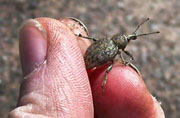 Cornell University entomologist Elson J. Shields and research specialist Antonio M. Testa have written an article on the “Biological Control of Alfalfa Snout Beetle with Persistent Entomopathogenic Nematodes: Expanding a Single Farm’s Success to an Area-Wide Biological Control Program” for the Winter 2017 issue of American Entomologist. The Northern New York Agricultural Development Program is acknowledged for its long-term funding of the research to develop the science of this project.
Cornell University entomologist Elson J. Shields and research specialist Antonio M. Testa have written an article on the “Biological Control of Alfalfa Snout Beetle with Persistent Entomopathogenic Nematodes: Expanding a Single Farm’s Success to an Area-Wide Biological Control Program” for the Winter 2017 issue of American Entomologist. The Northern New York Agricultural Development Program is acknowledged for its long-term funding of the research to develop the science of this project.